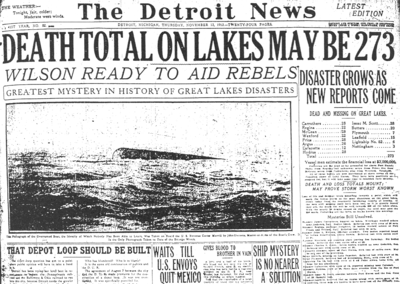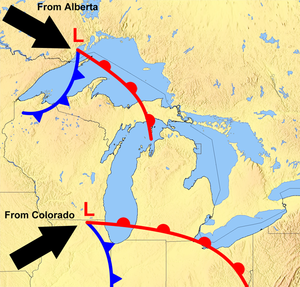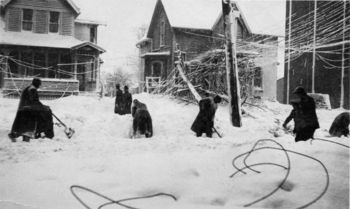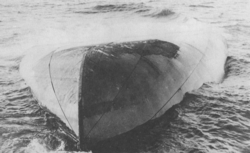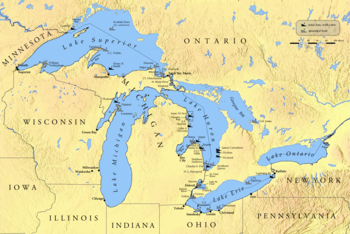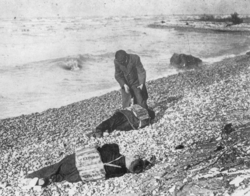Great Lakes Storm of 1913
2007 Schools Wikipedia Selection. Related subjects: Storms
The Great Lakes Storm of 1913, historically referred to as the "Big Blow," the "Freshwater Fury," or the "White Hurricane," was a blizzard with hurricane-force winds that devastated the Great Lakes basin in the United States Midwest and the Canadian province of Ontario from November 7, 1913, to November 10, 1913.
The deadliest and most destructive natural disaster to ever hit the lakes 1, the Great Lakes Storm killed over 250 people, destroyed 19 ships, and stranded 19 others. The financial loss in vessels alone was nearly US$5 million, or about $100 million in present-day adjusted dollars. The large loss of cargo, including coal, iron ore, and grain, meant short-term rising prices for consumer products throughout North America.
The storm originated as the convergence of two major storm fronts, fuelled by the lakes' relatively warm waters—a seasonal process called a "November gale". It produced 90 mph (145 km/h) winds, waves over 35 feet (11 m) high, and whiteout snow squalls.
Cause: the November gale
During autumn, cold, dry air moving south from northern Canada converges with warm, moist air moving north from the Gulf of Mexico, forming large storm systems in the middle of the continent. Several of these systems move along preferred paths toward the Great Lakes. When the cold air from these storms moves over the lakes, it is warmed by the waters below. This added heat postpones the arctic outbreak in the region, allowing the lakes to remain relatively warm for much longer than otherwise.
In November, two storm tracks converge over the Great Lakes. One travels southeastward from the province of Alberta; the other brings storms from the lee of the central Rocky Mountains northeastward toward the Great Lakes. This convergence is commonly referred to as a "November gale" or "November witch". When a cyclonic system moves over the lakes, its power is intensified by the jet stream above, and warm waters below. This allows the storm to maintain hurricane-force winds up to 100 mph (160 km/h), produce waves over 50 feet (15 m) high, and dump several feet of snow or inches of rain. Fuelled by the warm lake water, these powerful storms may remain over the Great Lakes for days. Intense winds then ravage the lakes and surrounding shores, severely eroding the shoreline, and flooding the coasts.
November gales have been a constant bane of the Great Lakes, with at least 25 killer storms striking the region since 1847. During the November gale of 1975, the giant ore bulk carrier SS Edmund Fitzgerald sank suddenly, without a distress signal.
Prelude to the storm
The storm was first noticed on Thursday, November 6, on the western side of Lake Superior, rapidly moving toward northern Lake Michigan. The weather forecast in The Detroit News called for "moderate to brisk" winds for the Great Lakes, with occasional rains Thursday night or Friday for the upper lakes (except on southern Lake Huron), and fair to unsettled conditions for the lower lakes.
Around midnight, the steamer Cornell, while 50 miles (80 km) west of Whitefish Point in Lake Superior, ran into a sudden northerly gale and was badly damaged. This gale would last until late Monday, November 10, almost forcing Cornell ashore. This would be the shape of things to come.
The storm
November 7
On Friday, the weather forecast in the Port Huron Times-Herald in Port Huron, Michigan, described the storm as "moderately severe." By then, the storm was centered over the upper Mississippi Valley, and had caused moderate to brisk southerly winds with warmer weather over the lakes. The forecast predicted increased winds and falling temperatures over the next 24 hours.
At 10:00 AM, Coast Guard stations and United States Department of Agriculture (USDA) Weather Bureau offices at Lake Superior ports raised white pennants above square red flags with black centers, indicating a storm warning with northwesterly winds.
By late afternoon, the storm signal flags were replaced with a vertical sequence of red, white, and red lanterns, indicating that a hurricane with winds over 74 mph (119 km/h) was coming. The winds on Lake Superior had already reached 50 mph (80 km/h) and an accompanying blizzard was moving toward Lake Huron.
November 8
By Saturday, the storm had been changed to " severe" status, and was centered over eastern Lake Superior, covering the entire lake basin. The weather forecast from the Port Huron Times-Herald stated that southerly winds had remained "moderate to brisk". Northwesterly winds had reached gale strength on northern Lake Michigan and western Lake Superior, with winds up to 60 mph (97 km/h) at Duluth, Minnesota.
That morning, assistant engineer Milton Smith of the bulk carrier Charles S. Price looked at the weather forecast in Cleveland, Ohio, and decided not to join the crew on their voyage. For the past few days, Smith had felt uneasy about this trip; he tried to talk his friend and neighbour, wheelsman Arz McIntosh, into leaving with him, but McIntosh claimed that he needed the money. Bert L. Reynolds of Cleveland was hired to replace Smith before Price departed from Ashtabula, Ohio.
There was a false lull in the storm, called a sucker hole, allowing traffic to begin flowing again, both down the St. Marys River and up Lake Erie, and the Detroit and St. Clair rivers, into Lake Huron. The gale wind flags raised at over a hundred ports were ignored. Long ships traveled all that day through the St. Marys River, all night through the Straits of Mackinac, and early Sunday morning up the Detroit and St. Clair rivers.
November 9
By noon on Sunday, weather conditions on lower Lake Huron were relatively normal for a November gale. Barometric pressures in some areas actually began to rise, bringing hope of an end to the storm. The low pressure area which had moved across Lake Superior was moving northeast, away from the lakes.
The Weather Bureau had sent out its twice daily reports at approximately 8:00 AM, and would not send another set of reports to Washington, D.C., till around 8:00 PM. This proved to be gravely unfortunate for the Great Lakes region, as the storm would have the better part of a day to build up hurricane forces before the Bureau headquarters in Washington, D.C., would have detailed information.
Along southeastern Lake Erie, near the city of Erie, Pennsylvania, a southern low pressure area was moving toward the lake. This low had formed overnight, and so was absent from Friday's weather map. It had been traveling northward, and began moving northwestward after passing over Washington, D.C.
The intense counterclockwise rotation of the low was made apparent by the changing wind directions around its centre. In Buffalo, New York, morning northwest winds had shifted to northeast by noon, and were blowing southeast by 5:00 PM, with the fastest gusts, 80 mph (130 km/h), occurring between 1:00 PM and 2:00 PM. Just 180 miles (290 km) to the southwest, in Cleveland, building winds remained northwest during the day, shifting to the west by 5:00 PM, and maintaining speeds over 50 mph (80 km/h). The fastest gust in Cleveland, 79 mph (127 km/h), occurred at 4:40 PM. Also of note is the dramatic drop in barometric pressure in Buffalo, from 29.52 inHg (999.7 hPa) at 8:00 AM to 28.77 inHg (974.3 hPa) at 8:00 PM.
The rotating low continued along its northward path into the evening, bringing its counterclockwise winds in phase with the northwesterly winds already hitting Lakes Superior and Huron. This resulted in an explosive increase in northerly wind speeds and swirling snow. Ships on Lake Huron that were south of Alpena, Michigan, especially around Harbour Beach and Port Huron in Michigan and Goderich and Sarnia in Ontario, were battered with huge waves moving southward toward St. Clair River.
From 8:00 PM to midnight, the storm became what modern meteorologists call a " weather bomb". Sustained hurricane-speed winds over 70 mph (110 km/h) ravaged the four western lakes. The worst damage was done down Lake Huron as numerous ships scrambled for shelter along its southern end. Gusts of 90 mph (140 km/h) were reported off Harbour Beach, Michigan. The lake's shape allowed northerly winds to increase unchecked, due to the lower surface friction of water compared to land, and the ability of wind to guide itself down the long axis of a body of water.
In retrospect, weather forecasters of the time did not have enough data or understanding of atmospheric dynamics to predict or comprehend the events of Sunday, November 9. Frontal mechanisms, referred to then as " squall lines", were not yet understood. Surface observations were collected only twice daily at various stations around the country, and by the time this data was collected and hand-drawn maps were created, the information was already hours behind actual weather conditions.
November 10 and 11
On Monday morning, the storm had moved northeast of London, Ontario, dragging lake effect blizzards in its wake. An additional 17 inches (43 cm) of snow were dumped on Cleveland, Ohio that day, filling the streets with snow drifts 6 feet (2 m) high. Streetcar operators stayed with their stranded, powerless vehicles for two nights, eating whatever food was provided by local residents. Travelers were forced to take shelter and wait for things to clear up.
By Tuesday, the storm was rapidly moving across eastern Canada. Without the warm lake waters, it lost power quickly. This also meant less snowfall, both because of the fast motion of the storm and the lack of lake effect snow. All shipping was halted on Monday and part of Tuesday along the St. Lawrence River around Montreal, Quebec.
Aftermath
Historically, storms of such magnitude and with such high velocities haven't lasted more than four or five hours. This storm, however, raged at an average speed of 60 mph (100 km/h) for over sixteen hours, with frequent bursts of over 70 mph (110 km/h). It crippled traffic on the lakes and throughout the Great Lakes basin region.
Surrounding shoreline
Along the shoreline, blizzards shut down traffic and communication, causing hundreds of thousands of dollars in damage. A 22-inch (56 cm) snowfall in Cleveland, Ohio, put stores out of business for two days. There were four-foot (122 cm) drifts around Lake Huron. Power was out for several days across Michigan and Ontario, cutting off telephone and telegraph communications. A Chicago, Illinois, park project, eight years in the making, was destroyed in as many hours.

After the final blizzards hit Cleveland, the city was paralyzed under feet of snow and ice, without power for days. Telephone poles had been snapped like twigs, and power cables lay in tangled masses. From the November 11 Cleveland Plain Dealer:
- "Cleveland lay in white and mighty solitude, mute and deaf to the outside world, a city of lonesome snowiness, storm-swept from end to end, when the violence of the two-day blizzard lessened late yesterday afternoon."
- "Take it all in all—the depth of the snowfall, the tremendous wind, the amount of damage done and the total unpreparedness of the people—I think it is safe to say that the present storm is the worst experienced in Cleveland during the whole forty-three years the Weather Bureau has been established in the city." — William H. Alexander, Cleveland's official observer
On the lakes
The greatest damage was done on the lakes. Major shipwrecks occurred on all but Lake Ontario, with most happening throughout southern and western Lake Huron.
Personal accounts of lake masters were that waves reached at least 35 feet (11 m) in height. Being shorter in length than waves ordinarily formed by gales, they occurred in rapid succession, with three waves frequently striking one after the other. Masters have also stated that the wind often blew in directions opposite to the waves below. This was the result of the storm's cyclonic motion, something rarely seen on the Great Lakes.
In the late afternoon of November 10, an unknown vessel was spotted floating upside-down in about sixty feet of water on the eastern coast of Michigan, within sight of Huronia Beach and the mouth of the St. Clair River. Determining the identity of this "mystery ship" became of regional interest, resulting in daily front page newspaper articles. The ship eventually sank to the bottom, and it was not until early Saturday morning, November 15, that it was finally identified as Charles S. Price. The front page of that day's Port Huron Times-Herald extra edition read, "BOAT IS PRICE — DIVER IS BAKER — SECRET KNOWN". Milton Smith, the assistant engineer who decided at the last moment not to join his crew on premonition of disaster, aided in identifying any bodies that were found.
The final tally of financial losses included US$2,332,000 for vessels totally lost, $830,900 for vessels that became constructive total losses, $620,000 for vessels stranded but returned to service, and approximately $1,000,000 in lost cargoes. This does not include financial losses in coastal cities.
There were several long-term consequences of the storm. Complaints against the USDA Weather Bureau of alleged unpreparedness resulted in increased efforts to achieve more accurate weather forecasting and faster realization and communication of proper storm warnings. Criticism of the shipping companies and shipbuilders led to a series of conferences with insurers and mariners to seek safer designs for vessels. This resulted in the construction of ships with greater stability and more longitudinal strength. Immediately following the blizzard of Cleveland, Ohio, the city initiated a campaign to move all utility cables underground, in tubes beneath major streets. The project took half a decade.
Ships foundered
The following list includes ships which sank during the storm, killing their entire crews. It is sorted geographically by the lake on which each ship disappeared, and alphabetically by the name of the ship. This list does not include the three victims from the freighter William Nottingham, who volunteered to leave the ship on a lifeboat in search of assistance. While the boat was being lowered into the water, a breaking wave smashed it into the side of the ship. The men disappeared into the near-freezing waters below.
- Lake Superior
- Leafield: 18 victims
- Henry B. Smith: 23 victims
- Lake Michigan
- Plymouth ( barge): 7 victims
- Lake Huron
- Argus: 28 victims
- James Carruthers: 22 victims
- Hydrus: 25 victims
- John A. McGean: 28 victims
- Charles S. Price: 28 victims
- Regina: 20 victims
- Isaac M. Scott: 28 victims
- Wexford: 20 victims
- Lake Erie
- Lightship 82: 6 victims
Of the twelve ships that sank in the storm, five have never been found: Henry B. Smith, Leafield, James C. Carruthers, Hydrus, and the barge Plymouth. The most recent discovery was that of Wexford in the summer of 2000.
Quotations
- "I knew it was storming before I was told. The rooms, the corridors, everywhere within this building vibrates with the power of the storm outside. The storm waves, like sound waves or the waves of the wireless, will not be denied by stone walls and plate glass windows." — Helen Keller, trapped in a hotel during the Cleveland blizzard, after having completed a public lecture
- "Dear wife and Children. We were left up here in Lake Michigan by McKinnon, captain James H. Martin tug, at anchor. He went away and never said goodbye or anything to us. Lost one man yesterday. We have been out in storm forty hours. Goodbye dear ones, I might see you in Heaven. Pray for me. / Chris K. / P.S. I felt so bad I had another man write for me. Goodbye forever." — message found in a bottle 11 days after Plymouth disappeared, dictated by Chris Keenan, federal marshal in charge of the barge
- "No lake master can recall in all his experience a storm of such unprecedented violence with such rapid changes in the direction of the wind and its gusts of such fearful speed... It was unusual and unprecedented and it may be centuries before such a combination of forces may be experienced again." — excerpt from Lake Carriers' Association report, 1913
- "Erie, and Ontario, and Huron, and Superior, and Michigan — possess an ocean-like expansiveness, with many of the ocean's noblest traits... they are swept by Borean and dismasting blasts as direful as any that lash the salted wave; they know what shipwrecks are, for out of sight of land, however inland, they have drowned full many a midnight ship with all its shrieking crew." — Herman Melville, Moby-Dick (1851)
- Gordon Lightfoot, in the song The Wreck of the Edmund Fitzgerald:
-
- The legend lives on from the Chippewa on down
- Of the big lake they call Gitche Gumee
- Superior, they said, never gives up her dead
- When the gales of November come early.
- Of the big lake they call Gitche Gumee
- The legend lives on from the Chippewa on down
